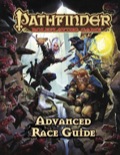Advanced Race Guide Preview: Kill it With Fire!
Tuesday, May 1, 2012
Everyone knows goblins have an unnatural love of fire. They love to see it flicker and burn to the sounds of their enemies' screams. While goblin adventurers, in an effort to get along with other more squeamish races, may control their pyromaniac urgings, others learn to harness that power and focus it into devastating force.
Of course, since the goblin section of the Advanced Race Guide has plenty of options for fiery destruction, an alchemist archetype focusing on fire seemed like a good fit, so this week we present you with the fire bomber. As you'll notice from this archetype, there are many more options for goblin mayhem in this book, from a host of feats to some new discoveries, but you will just have to wait until the book comes out to check those out.
Fire Bomber (Alchemist)
Fire bombers are exceptionally good at using bombs to burn creatures and blow things up, but are not quite as good at creating other types of bombs or extracts. A fire bomber has the following class features.
Weapon and Armor Proficiency: A fire bomber treats torches as a simple weapon.
Fire Bombardier (Su or Ex): At 1st level, when a fire bomber throws a bomb that deals fire damage, all creatures in the splash radius take an additional point of damage per die of fire damage dealt. Fire bombers only add their Intelligence bonus to damage from bombs or alchemical substances that deal fire damage. This otherwise works like the alchemist's bomb and throw anything abilities. This ability alters bomb and throw anything.
Bonus Feats: A fire bomber can select the Burn! Burn! Burn!, Fire Tamer, or Flame Heart feat in place of a discovery.
Fiery Cocktail (Su): At 4th level, whenever a fire bomber uses a discovery that deals damage other than fire damage, he can split the damage dice evenly between the bomb's primary damage type and 1d6 points of fire damage; when there is an odd number of damage dice, the odd die of damage comes from the primary damage type. For example, an 8th-level fire bomber could throw a concussive bomb that deals 2d6 points of fire damage and 3d4 points of sonic damage. Additional effects from the bomb still apply, but the save DC for admixture bombs is reduced by 2. This replaces the alchemist's 4th-level discovery.
Fire Body (Ex): At 8th level, a fire bomber adds elemental body I to his extract list as a 3rd-level extract. Elemental body extracts prepared using fire body are limited to fire elementals only. This ability replaces poison resistance +6.
Improved Fire Body (Ex): At 10th level, fire bombers add elemental body II to their spell list as a 4th-level extract. Elemental body extracts prepared using improved fire body are limited to fire elementals only. This ability replaces poison immunity.
Greater Fire Body (Ex): At 14th level, fire bombers add elemental body IV to their spell list as a 5th-level extract. Elemental body extracts prepared using greater fire body are limited to fire elementals only. This ability replaces persistent mutagen.
Discoveries: The following discoveries complement the fire bomber archetype: fire brand, rocket bomb (see sidebar); explosive bombs, fast bombs, inferno bomb, precise bombs (Advanced Player's Guide); breath weapon bomb, explosive missile, immolation bomb (Ultimate Combat); bottled ooze, confusion bomb, strafe bomb (Ultimate Magic).
Next week, WARK!
Stephen Radney-MacFarland
Designer
We have updated our Privacy Policy.
Paizo.com uses cookies. You can block paizo.com from using cookies within your browser settings, but doing so will hinder site functionality.
More information can be found in our Privacy Policy.

